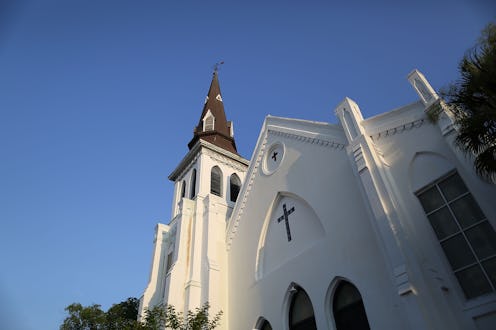News
Stats On Racial Violence Are Damagingly Misleading
In the two weeks since the Charleston shooting, seven black churches have caught fire. The Bureau of Alcohol, Tobacco, Firearms, and Explosives is leading investigations into five of the cases — three of which have been identified as arson or potential arson, according to the Washington Post. The Associated Press published a story Thursday that said statistics actually show that church fires are not unusual, and the vast majority of cases are not intentional or hate-filled. Though these statistics are accurate, the story undermines the fact that racially-motivated attacks on black churches are not anomalies, and, though white churches have seen arson attacks, the attacks aren't often associated with racial violence. Portraying the problem of aggression and violence against black people with blanketed statistics that don't examine the nuance behind the issue is not helping our problems with racism and inequality.
About 84 percent of fires at houses of worship around the U.S. are not intentionally set, according to data cited by the AP. From 2007 to 2011, about 16 percent of fires at places of worship and funeral homes were set intentionally by arsonists. That means that of the average 31 congregations that caught fire every week, about five were the result of arson. But, the next sentence in the AP's story presents a glaring problem with presenting data like this to calm the minds of Americans: "Those figures do not break out predominantly white congregations from black congregations," the story says. SIGH.
This is the crux of a lot of data about violence in the United States. Yes, police officers shoot unarmed people in the U.S. often, but most of those people they shoot are black. And that presents us with two important problems: first, that officers are shooting unarmed people at an alarming rate; and, second, that — for whatever myriad of social and cultural reasons — they are shooting black people more often than white people.
The Clinton task force found that whites represented 63 percent of the people arrested for bombing or burning black churches in the late 1990s, and 37 percent were black, according to the New York Times. Of those stats, not all of the crimes were racially motivated. Some were vandals or pyromaniacs, while others allegedly tried to cover up burglaries or financial theft or simply held grudges, according to the Times.
In that same period, a slew of fire-bombing attacks struck black churches across the nation, concentrating in the Southeast, according to The Atlantic. In South Carolina alone, black churches that suffered probable arson attacks from 1994 to 1996 included Mt. Zion AME Church in Williamsburg (the site of one of the recent church fires), Macedonia Baptist Church in Manning, Saint Paul Baptist Church in Lexington, Rosemary Baptist Church in Barnwell, St. John Baptist Church in Dixiana, Effington Baptist Church, Mount Olivet Baptist Church, and Allen’s Chapel. One member of Congress said the fire-bombings in those years were like “the return of a biblical plague," according to The Atlantic.
The last black church fire to make national headlines prior to the Charleston shooting occurred in Massachusetts, on the day President Barack Obama was inaugurated as the first black president. A white man was later convicted of arson in what prosecutors described as a racially-motivated attack, according to The Atlantic.
The FBI's most recent hate crime statistics show that black victims made up 66 percent of hate crimes in 2013. Of all hate crimes, 21 percent were motivated by anti-white bias, according to The Atlantic. (Let's keep in mind just how hard it is to prove a hate crime, which often means that statistics for racially-motivated hate crimes don't include instances that couldn't be proven in court.)
Why does all of this matter? Because statistics that try to normalize attacks on churches or make us feel a bit better about the increase of recent attacks by saying "Actually, this is pretty normal!" just aren't OK. It's nice to know that racially-motivated attacks are rare, but it's hard to prove racially-motivated attacks, and we know that black people are faced with aggression and violence every day. Even the proven hate-filled arsons happen at least five times a week. Five times a week. What's even worse is that the stats presented by the AP and other publications generally weren't accompanied by the fact that black churches are often targeted by white people, according to the Clinton task force's data. Further, black churches have been targeted with violence to trigger widespread intimidation; see the one after Obama's inauguration and the ones following the attack in Charleston. (Alleged Charleston shooter Dylann Roof told police he wanted "to start a race war.")
The statistics presented by the AP are useful in the grand scheme of things, but it seems irresponsible for us to not investigate what proportion of arsons are racially-motivated. The stakes of racial inequality are too high for us to not push harder on questions surrounding historical violence.
Images: Getty Images (2)
